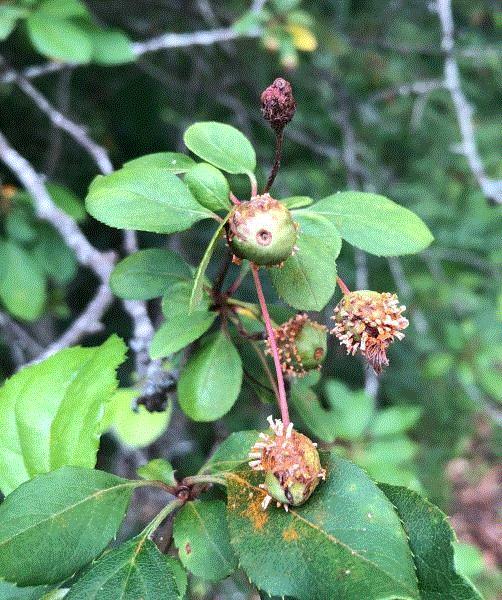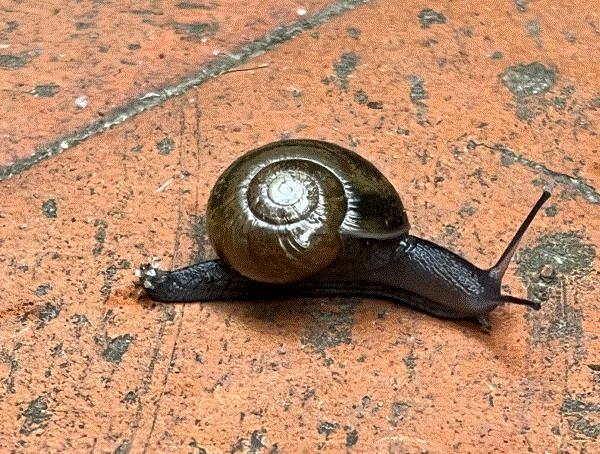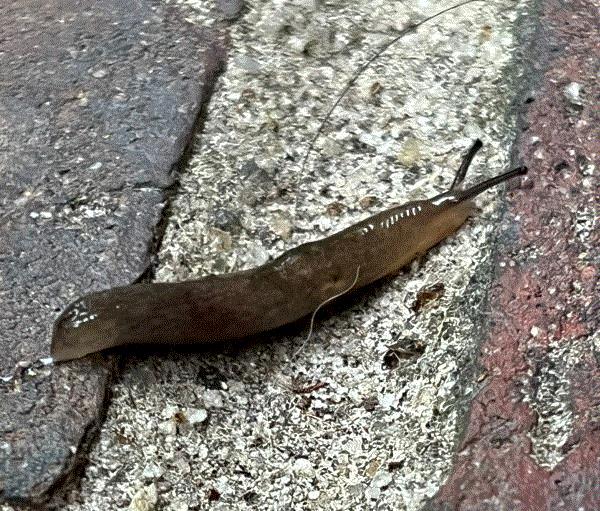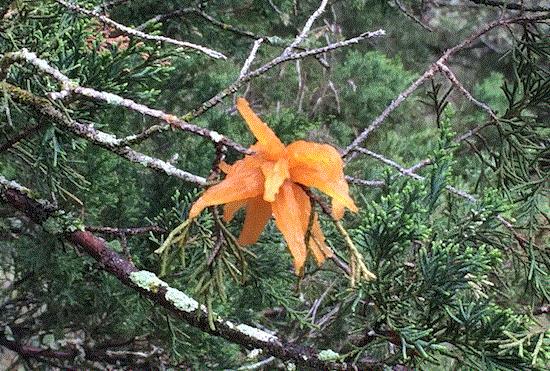What the ... ?
The weather has been crazy the past couple of weeks. I was in shorts when I flew back from a trip to Texas last Friday and I had to put on my sweater before I even got to the garage at Charleston International Airport. Where did my summer go?
Despite an occasional dip in temperature, it’s certainly warming up in my neck of the woods. With that comes all sorts of interesting finds. Here's something interesting I’d wanted to share last week. Looks like some protrusions from crabapples grown in front of my house. What are they? This case is an easy one, I know, but still fun to look at.

Box Tree Moth Quarantine Established in Michigan
On May 30, USDA-APHIS announced the establishment of a quarantine for box tree moth in all of Lenawee and Washtenaw Counties, and parts of Jackson and Monroe Counties in Michigan. The quarantined area is to the southwest of Detroit.
This quarantine was brought about by the detection of box tree moth larvae in Lenawee County, and parallels the intrastate quarantine established by the Michigan Department of Agriculture and Rural Development (MDARD) on April 10. Movement of regulated items out of these counties (both intrastate and interstate) is now limited. APHIS, MDARD and other partners will be conducting research and outreach activities in the area. Regulated items include the whole plant, all plant parts, pieces, cuttings, clippings, debris and any portion of the plants, alive or dead.
Click HERE to find out more about the quarantine in Michigan and click HERE for more information on box tree moth in Michigan.
Snail and Slug Webinar Recording Now Available
The Washington Invasive Species Council held an invasive snail and slug workshop on April 27. I missed the workshop, but lucky me, the recording of that workshop is now available by clicking HERE.
Expert speakers from USDA, the Florida Department of Agriculture and Consumer Services, Oregon State University and Invasive Councils from Washington and Montana talked about various mollusk-related topics. The workshop started with an introduction to malacology and progressed to talks about specific snail and slug species of concern, such as eastern heath snail and giant African snail. (I didn’t know the study of mollusks is called malacology!)

If you're interested in mollusks or must manage them, this workshop has quite a bit of information for you. Click HERE to watch the recording.
How Do You Manage Snails and Slugs?
Some of us are in the unenviable position of listing slugs and snails as major pests. Unlike spider mites and whiteflies, there are few products we can just spray and see a reduction in population and damage from slugs and snails. Management of these mollusks truly requires a good understanding of their habits. The California Nursery Pest Snails and Slugs website provides good information on how to develop a management program.
The first step in management is not to pick out which bait to use. Instead, determine with some confidence that the damage you see is indeed caused by slugs or snails. That can be more difficult than you think because the damage by mollusks is similar to the damage caused by many foliage-feeding insects. Slugs and snails aren’t out to be seen during the day and you may not see slime trails. You should set up a beer trap (or sugar water and yeast) to capture the culprits if you suspect slugs and snails. By the way, don’t count on beer traps to be an effective mass trapping tool. Also, dump and refill the traps regularly to make sure there are liquid in the traps to attract and kill the mollusks.
Then you proceed to proper identification, just like what you’d do for spider mites and whiteflies. Knowing the identity of the snails and slugs will give you a good idea of their habits and the best treatment method and timing. I can usually guess the identity of a snail or slug based on its appearance and habitat, but for a more accurate identification, I go to the Terrestrial Mollusk Tool where I can use keys to identify the species. The Terrestrial Mollusk Tool also contains many fact sheets on various species.

The abundance of snails and slugs are tied to the amount of moisture in the environment, so moisture control (for example, irrigate early the day to allow the floor to dry and use drip irrigation) is an easy way to make a habitat less hospitable to snails and slugs. Cleaning up debris and hiding places (such as stacks of unused trays and pots) deny them food and shelter. Increased plant spacing also helps reduce moist, shaded habitats.
Strategically placed pots and boards can serve as traps instead of shelters. How frequently you check the pots and boards makes all the difference. If you want to create an ideal habitat, don’t move or disturb these pots and boards. If you want to use them as traps, these boards should also be checked regularly so that the snails and slugs hiding underneath can be killed or removed before they do damage.
Wrapping bands of copper flashing, copper screen or spraying copper sulfate around the legs of benches can prevent mollusks from climbing up. Copper fungicides don’t contain enough copper to serve this purpose, not to mention that the products isn’t registered for such use.
The most effective method of reducing snail and slug abundance is applying baits. Snail and slug baits contain metaldehyde, iron phosphate or spinosad. Metaldehyde baits are more effective during warm days, but they're poisonous to pets. Iron phosphate baits are safe to use around children and animals. Read a good summary of the pros and cons of each bait type on the California Nursery Pest Snails and Slugs website.
There's no biological control option for nurseries unless you consider herding ducks through rows of trees or pots as an effective method. A nematode, Phasmarhabditis hermaphrodita, is being used as a biological control agent in Europe. This nematode species is also found in California, but a product containing this nematode species is still some way from being registered.
How do you manage your snail or slug population? Share your experience with me.

Webinars to Celebrate Pollinator Week
June 19-23 is Pollinator Week. To celebrate, AmericanHort and the Horticultural Research Institute (HRI) have organized a series of pollinator-focused webinars for the green industry.
The celebration kicks off on June 19 with a webinar by Adam Dale of the University of Florida and Jaret Daniels of the Florida Museum of Natural History. Adam and Jaret will talk to us about the importance of protecting pollinators and the effects of insect pests on pollinators. Also, they’ll talk about how we can tailor our pest management strategies to protect pollinators.
Adam and Jaret’s webinar will be followed by two sessions by the esteemed Dan Potter of the University of Kentucky. Dan’s research covers various aspects of pollinator research and protection in nurseries and landscapes. On June 20, Dan will teach us how to build a better Monarch butterfly garden through design, plant placement and plant selection. On June 21, Dan will talk about the interplay among bees, pesticides and politics. This webinar isn’t meant to be a downer, but an engaging discussion about how landscape care professionals and gardeners can conserve pollinators while managing pests.
On June 22, Steve Foltz, Director of Horticulture at Cincinnati Zoo & Botanical Garden, will share his experience of selecting plants that can support pollinators in the Midwest. The Cincinnati Zoo & Botanical Garden has built an impressive program that supports both local community and pollinators.
All of the webinars are scheduled for 1:00-2:00 p.m. Eastern. Click HERE to find out more and register for the webinars. Registration is free.

Answer to “What the … ?”
A cool, wet spring promises an abundant crop of cedar-apple rust on my crabapples. This is an interesting disease that requires multiple host species to complete its life cycle. In my region, I often see the signs of cedar-apple rusts on eastern red cedar and crabapple.
There are four types of spores in the fungus’ life cycle. Telial horns, i.e. the gelatinous protrusions from the galls on red cedars or from the fruits of crabapples, appear after rain in the spring. Telial horns can dry up and rehydrate again. They also release teliospores, which grow on the telial horns and produce basidiospores. The basidiospores are carried by the wind to the leaves of the second host (say, a crabapple) and cause rust on the leaves.
The rusty leaf spots produce spermagonia, which are the structures that produce spermatia. Spermatia produce a sweet fluid, which attract insects that eventually carry the spores to a new host. The rust can also produce another structure, called aecia, on the underside of leaves. Aecia produce aeciospores, which are blown to a new host by wind. Aeciospores infest the new hosts, which produce galls where telial horns grow from, completing the life cycle.

What an interesting and complicated life cycle!
Apple growers manage cedar-apple rust to prevent yield loss. For ornamental plants grown in nurseries, fungicide application may be needed to prevent rust and leaf spots. For ornamental plants in the landscape, I don’t really think management is needed since the galls and rusts don’t really cause a decline in plant health. Some may want to spray just because the disease symptoms are ugly. Click HERE for more information on managing cedar-apple rust.



See y’all later!

JC Chong
Technical Development Manager at SePRO
Adjunct Professor at Clemson University
This e-mail received by 27,847 subscribers like you!
If you're interested in advertising on PestTalks contact Kim Brown ASAP!